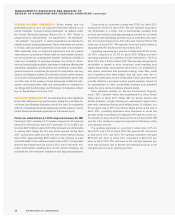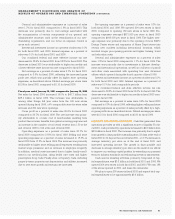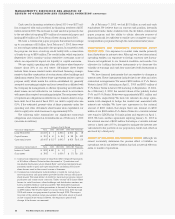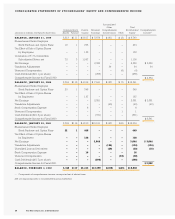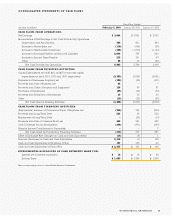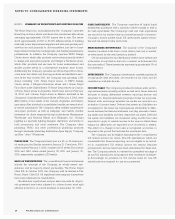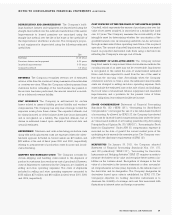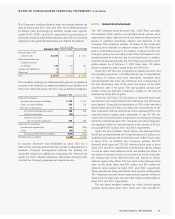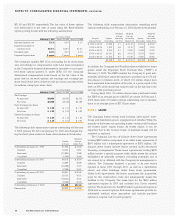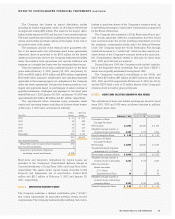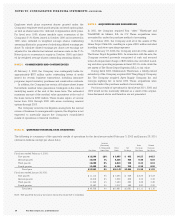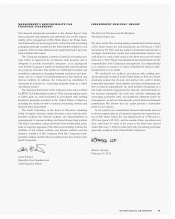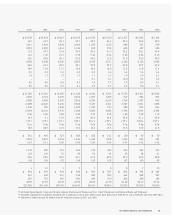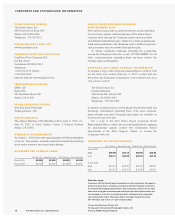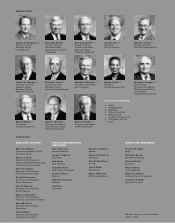Home Depot 2001 Annual Report Download - page 32
Download and view the complete annual report
Please find page 32 of the 2001 Home Depot annual report below. You can navigate through the pages in the report by either clicking on the pages listed below, or by using the keyword search tool below to find specific information within the annual report.
NOTES TO CONSOLIDATED FINANCIAL STATEMENTS (CONTINUED)
The Home Depot, Inc. and Subsidiaries30
COMPREHENSIVE INCOME Comprehensive income includes
net earnings adjusted for certain revenues, expenses, gains and
losses that are excluded from net earnings under generally
accepted accounting principles. Examples include foreign cur-
rency translation adjustments and unrealized gains and losses on
certain hedge transactions.
FOREIGN CURRENCY TRANSLATION The assets and liabilities
denominated in a foreign currency are translated into U.S. dollars
at the current rate of exchange on the last day of the reporting
period, revenues and expenses are translated at the average
monthly exchange rates, and equity transactions are translated
using the actual rate on the day of the transaction.
USE OF ESTIMATES Management of the Company has made a
number of estimates and assumptions relating to the reporting of
assets and liabilities, the disclosure of contingent assets and lia-
bilities, and reported amounts of revenues and expenses in
preparing these financial statements in conformity with generally
accepted accounting principles. Actual results could differ from
these estimates.
RECLASSIFICATIONS Certain amounts in prior fiscal years have
been reclassified to conform with the presentation adopted in the
current fiscal year.
NOTE 2. LONG-TERM DEBT
The Company’s long-term debt at the end of fiscal 2001 and fiscal
2000 consisted of the following (amounts in millions):
February 3, 2002 January 28, 2001
Commercial Paper; weighted
average interest rate of 6.1%
at January 28, 2001 $ – $ 754
61/2% Senior Notes; due September
15, 2004; interest payable semi-annually
on March 15 and September 15 500 500
53/8% Senior Notes; due April 1, 2006;
interest payable semi-annually on
April 1 and October 1 500 –
Capital Lease Obligations; payable
in varying installments through
January 31, 2027 232 230
Other 23 65
Total long-term debt 1,255 1,549
Less current installments 54
Long-term debt, excluding
current installments $1,250 $1,545
The Company has a commercial paper program with maximum
available borrowings up to $1 billion. In connection with the pro-
gram, the Company has a back-up credit facility with a consortium
of banks for up to $800 million. The credit facility, which expires in
September 2004, contains various restrictive covenants, none of
which are expected to materially impact the Company’s liquidity
or capital resources. Commercial paper borrowings of $754
million outstanding at January 28, 2001, were classified as non-
current pursuant to the Company’s intent and ability to finance this
obligation on a long-term basis.
The Company issued $500 million of 53/8% Senior Notes in
fiscal 2001 and $500 million of 61/2% Senior Notes in fiscal 1999,
collectively referred to as “Senior Notes.”The Senior Notes may
be redeemed by the Company at any time, in whole or in part, at
a redemption price plus accrued interest up to the redemption
date. The redemption price is equal to the greater of (1) 100% of
the principal amount of the Senior Notes to be redeemed or (2)
the sum of the present values of the remaining scheduled pay-
ments of principal and interest to maturity. The Senior Notes
are not subject to sinking fund requirements.
Interest expense in the accompanying Consolidated Statements
of Earnings is net of interest capitalized of $84 million, $73 million
and $45 million in fiscal 2001, 2000 and 1999, respectively.
Maturities of long-term debt are $5 million for fiscal 2002, $6
million for fiscal 2003, $507 million for fiscal 2004, $8 million for
fiscal 2005 and $509 million for fiscal 2006.
As of February 3, 2002, the market values of the publicly trad-
ed 53/8% and 61/2% Senior Notes were approximately $511 million
and $531 million, respectively. The estimated fair value of all other
long-term borrowings, excluding capital lease obligations,
approximated the carrying value of $23 million. These fair values
were estimated using a discounted cash flow analysis based on
the Company’s incremental borrowing rate for similar liabilities.
NOTE 3. INCOME TAXES
The provision for income taxes consisted of the following
(in millions):
Fiscal Year Ended
February 3, 2002 January 28, 2001 January 30, 2000
Current:
U.S. $ 1,594 $ 1,267 $ 1,209
State 265 216 228
Foreign 60 45 45
1,919 1,528 1,482
Deferred:
U.S. (12) 98 9
State (1) 9 (4)
Foreign 71 (3)
(6) 108 2
Total $ 1,913 $ 1,636 $ 1,484


